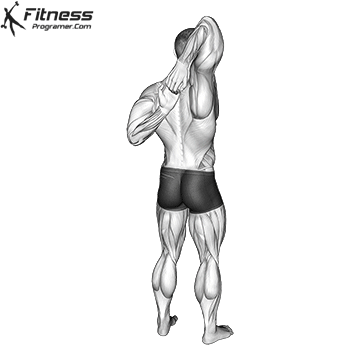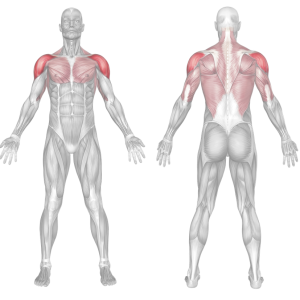Shoulder Stretch Behind The Back Overview
The Shoulder Stretch Behind the Back is a static stretch designed to improve shoulder flexibility, mobility, and posture. It primarily targets the muscles and joints in the shoulders, while also engaging the chest, upper back, and arms. This stretch is particularly beneficial for releasing tension in the shoulders caused by poor posture, prolonged sitting, or repetitive upper-body movements.
Who Should Perform This Stretch?
- Office Workers: Helps alleviate tension from prolonged sitting and poor posture.
- Athletes and Lifters: Improves shoulder mobility, aiding performance in sports and weightlifting.
- Older Adults: Maintains shoulder health and prevents stiffness associated with aging.
- Individuals in Rehab: Gentle enough for recovery programs, with modifications as needed.
How to perform the Shoulder Stretch Behind the Back

Standing Variation:
- Stand in a neutral posture with your feet shoulder-width apart.
- Raise one arm overhead and bend the elbow to reach behind your back.
- Simultaneously, bring the other arm behind your back from below, aiming to touch or overlap your fingers.
- Do they touch, or are they close to touching? Are they overlapping?Does one side feel tighter than the other?
- Switch sides and note your results.
- Hold a towel or resistance band in both hands behind your back.
- Use the towel to assist in pulling your arms into the stretch if clasping your hands is challenging.
- Follow the same technique as above, ensuring a controlled stretch.
Shoulder Flexibility Test
The Shoulder flexibility test is a simple flexibility test to determine whether the hands can be brought together from behind and to detect shoulder range of motion.
Measure distance from finger tip to finger tip. If fingers overlap, score as a plus. If fingers fail to meet, score as a minus.
- Fingers overlap / Excellent
- Fingers are touching / Good
- Fingertips are not touching but are less than two inches (5cm) apart. / Fair
- Fingertips are greater than two inches (5cm) apart. / Poor
Tips for Maximum Effectiveness
- Start Gradually: Begin with a smaller range of motion and increase as your flexibility improves.
- Pair with Other Shoulder Stretches: Combine this stretch with movements like reverse shoulder stretches or assisted stretches for a comprehensive routine.
- Incorporate into Work Breaks: Use this stretch during long periods of sitting to reduce tension and improve posture.
- Breathe Deeply: Take slow, deep breaths during the stretch to help relax the muscles and enhance flexibility.
Common Mistakes to Avoid
- Overarching the Back: Keep your core engaged to avoid excessive arching in the lumbar spine.
- Hunching the Shoulders: Ensure your shoulders are pulled back and down, rather than shrugged upward.
- Using Momentum: Perform the stretch slowly and with control to avoid jerking motions that can strain the muscles.
- Forcing the Range of Motion: Stretch only to a comfortable point; avoid overextending the shoulders.
Benefits of the Shoulder Stretch Behind the Back
- Improved Shoulder Flexibility
- Enhances the range of motion in the shoulders, making it easier to perform overhead or reaching movements.
- Better Posture
- Opens up the chest and pulls the shoulders back, counteracting the effects of hunching or slouching.
- Relieves Muscle Tension
- Reduces tightness in the shoulders, chest, and upper back, particularly for those with desk jobs or frequent overhead lifting.
- Prevents Injuries
- Increases flexibility and mobility, which can reduce the risk of strains, particularly in sports or resistance training.
- Improves Athletic Performance
- Prepares the shoulders for dynamic movements, benefiting activities like throwing, swimming, or weightlifting.
- Versatility and Accessibility
- Can be performed anywhere, with or without equipment, and is suitable for all fitness levels.
Muscles Worked

